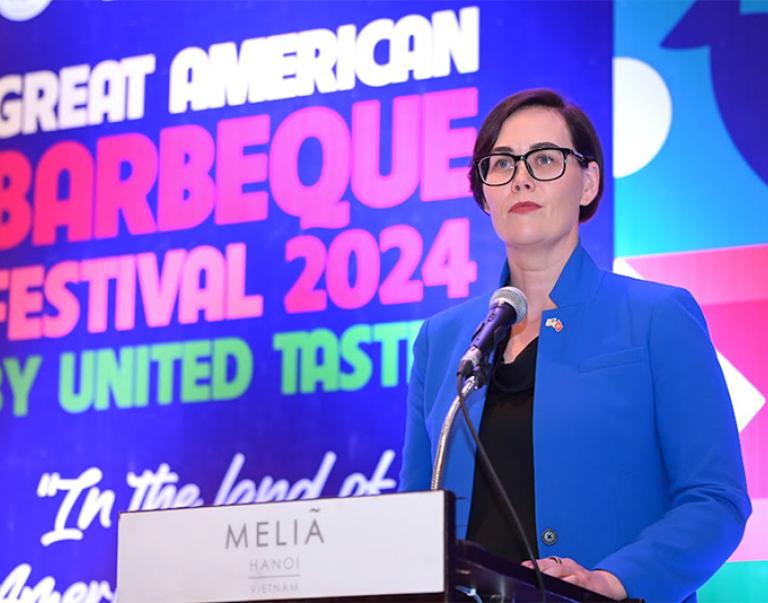STATE COLLEGE, Pa., Oct. 5, 2016 – At the White House Rural Forum convened today at Pennsylvania State University, Agriculture Secretary Tom Vilsack announced $32 million in loans and grants that will promote economic development and provide access to broadband in more than 80 rural American communities. Vilsack, who is chair of the first-ever White House Rural Council, convened the forum with rural policy, business and nonprofit leaders to discuss pertinent issues facing rural communities, including opportunities for economic growth and strategies for improving health care and housing.
"This funding will provide much-needed capital and bring cutting-edge technology to rural communities across the country," Vilsack said. "Investments in our rural businesses and communities, coupled with extending high-speed broadband, have led to a resurgence of economic development, created jobs and improved the quality of life in rural America. While we have made great progress, our work to extend capital and technology to rural America is not done."
Significant gains have been made across rural America: Rural household income climbed 3.4 percent in 2015, overall poverty and food insecurity fell dramatically, rural populations have begun to rebound, non-metro areas have added more than 250,000 jobs since 2014, and the share of rural Americans without health insurance is now at an all-time low.
The White House Rural Council, established by President Obama in 2011, coordinates the Administration's efforts in rural America by streamlining and improving the effectiveness of federal programs, engaging stakeholders on priority issues, and coordinating private-sector partnerships to create economic opportunity and improve the quality of life.
With today's funding, USDA is investing in 86 projects through the Rural Economic Development Loan and Grant program, the Rural Microentrepreneur Assistance Program, the Intermediary Relending Program, the Rural Business Development Grant Program and the Community Connect program.
Examples of funded projects include:
- Jackson Energy Cooperative Corporation in McKee, Ky., will receive a $1 million Rural Economic Development loan to help the Kentucky Highlands Real Estate Corporation retrofit an industrial building. The newly updated building, located in Rockcastle County, will be leased to a private contractor that processes medical records for the Veterans Administration. This project is expected to create 190 jobs.
- Pine Telephone Company in Broken Bow, Okla., will receive a $3 million Community Connect grant to build a state-of-the-art fiber network serving the Choctaw Nation Tribal Jurisdiction. The money will also support staff for a community center where individuals without computers can access the internet.
- The city of Anamoose, N.D., will receive a $218,462 Rural Business Development Grant to renovate a former bank building. The refurbished building will be leased to a new restaurant that will feature an evening and weekend menu using locally-grown produce and meats.
USDA Rural Development's business and telecommunications programs have had a significant impact on rural lives and economies. In 2014, USDA provided a $250,000 Rural Economic Development grant to Douglas Electric Cooperative, Inc. in Armour, S.D., that it used to help the Delmont Fire Protection District rebuild its fire hall. The previous fire hall had been destroyed by a tornado.
At the Rural Forum, Vilsack also announced that more than $3 billion has been invested since 2014 into rural infrastructure projects through a public-private partnership with Capitol Peak Asset Management and CoBank, a national cooperative bank and member of the Farm Credit System. Since USDA initiated the partnership, the private-sector funding has helped finance more than 400 projects in the power, water, communications and community facilities industries.
Finally, Vilsack announced the continuation of the Rural Integration Models for Parents and Children to Thrive (Rural IMPACT) demonstration project that was launched last year. Rural IMPACT helps communities adopt a two-generation approach to addressing the needs of vulnerable children and their parents. Its goal is to increase parents' employment and education and improve the health and well-being of their children and families.
Rural IMPACT is led by the Department of Health and Human Services in collaboration with USDA, the Department of Labor, the Corporation for National and Community Service, the Appalachian Regional Commission, the Delta Regional Authority, the Annie E. Casey Foundation, the W.K. Kellogg Foundation and other philanthropic partners. These partners have selected 10 local and tribal communities to receive technical assistance and capacity-building resources to reduce child poverty, and placed AmeriCorps VISTA members there. The partners are pleased to announce these member will be placed in the 10 Rural IMPACT communities for a second year.
Since 2009, USDA Rural Development (@USDARD) has invested nearly $13 billion to start or expand nearly 112,000 rural businesses; helped bring high-speed Internet access to nearly 6 million rural residents and businesses; helped 1.1 million rural residents buy homes; and funded nearly 9,200 community facilities such as schools, public safety and health care facilities. USDA also has invested $31.3 billion in 963 electric projects that have financed more than 185,000 miles of transmission and distribution lines serving 4.6 million rural residents. For more information, visit www.usda.gov/results.
#
USDA is an equal opportunity provider, employer and lender.



